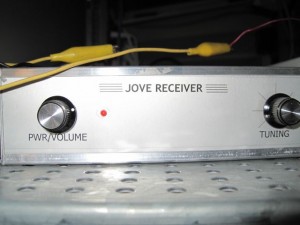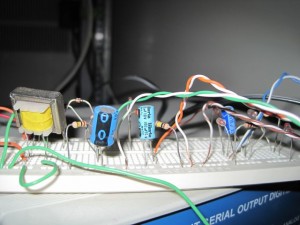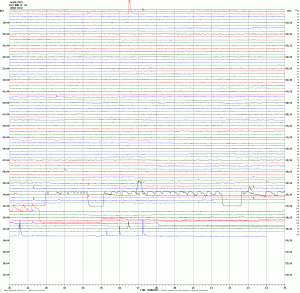For my home observatory, I started with the Radio Jove receiver from NASA’s Radio Jove Project.
This was a fairly easy-to-build kit with great directions, not just for the receiver but also the antenna setup and installation. Unfortunately, I don’t have enough space to put up a phased antenna array. Also, I’m bordered by power lines on the north and south sides of my property. Also, since I’m in an urban area, I knew that I’d pick up a lot of noise. Not to worry. Solar observations are also quite interesting, and since the Sun is such a good signal source (especially so far this year), I opted for an antenna in my attic.
The basic components of my system are the Radio Jove receiver, a set of integration circuits, a digitizer and some software to process the data.
For the integration circuits, I’ve tried a few different versions. As I like to keep tinkering, the current integration circuits are on a breadboard.
I chose the 16-bit digitizer from Webtronics.
I chose this digitizer for a few reasons. Many Radio Jove(RJ) observers use their computer sound cards and some processing software. As that software only runs on Windows and I wanted to run this on a headless (no monitor, keyboard or mouse), I opted for a solution running on Unix or Linux. For my day job, I work at the University of Utah Seismograph Stations. We’ve been using the Webtronics digitizers for a while in remote locations to process seismic data. Further, I opted to use some of our seismic data acquisition and plotting software to produce graphics of the data I collected.
For those of you who’ve seen the traditional earthquake helicorder, this might look almost familiar. The chart shows 24 hours of data, in 15-minute horizontal traces. The colors are just used to differentiate the 15-minute slice. Times in standard time are on the left side, in UTC on the right. On the extreme right is a DC offset. In order to keep the traces from jumping all over the image, data for the first 1-2 minutes are used to determine a DC offset to bring the trace back on center. Which is why there are traces that jump up for a while and then later seem to drop off. If you look at the DC offset values, you’ll see a large signal was observed for part of that time.




